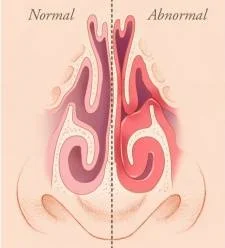
turbinoplasty, also known as turbinate reduction surgery, is a surgical procedure that involves reducing the size of the turbinates, which are structures inside the nose that help to warm and humidify the air as it passes through the nasal passages. The turbinates are made up of bone and soft tissue, and they can become enlarged due to a variety of factors
How it is performed
During turbinate reduction surgery, the surgeon will make incisions inside the nose and use various tools, such as a microdebrider or radiofrequency device, to remove or reduce the size of the turbinates. The goal of the procedure is to improve airflow through the nasal passages and alleviate symptoms such as congestion, snoring, and sleep apnea.
Why is the surgery done
Turbinoplasty or turbinate reduction surgery is done to address various nasal conditions that affect breathing and cause nasal obstruction. The primary reason for turbinate reduction surgery is to alleviate nasal obstruction and improve breathing through the nasal passages. Here are some of the most common reasons
- Chronic nasal congestion: Turbinate reduction surgery can be performed to address chronic nasal congestion caused by enlarged turbinates. This can be due to allergies, infections, or structural abnormalities.
- Sleep apnea and snoring: Enlarged turbinates can contribute to sleep apnea and snoring. By reducing the size of the turbinates, airflow can be improved, reducing the severity of these conditions.
- Difficulty breathing: Turbinate reduction surgery can be done to address difficulty breathing through the nose, which can be caused by enlarged turbinates or other structural abnormalities.
- Nasal polyps: Turbinate reduction surgery can be part of the treatment plan for nasal polyps, which are growths that can develop in the nasal passages and cause obstruction.
- Other nasal conditions: Turbinate reduction surgery can also be done in conjunction with other nasal surgeries, such as septoplasty or rhinoplasty, to improve breathing and address structural abnormalities.
What to expect post surgery
Turbinate reduction surgery is typically performed as an outpatient procedure under local or general anesthesia. Recovery time varies, but most patients are able to return to work and normal activities within a week or two after the procedure. Some discomfort and congestion are common after the surgery, but these symptoms typically resolve within a few weeks.
Risks associated with the surgery
Turbinate reduction surgery is typically performed as an outpatient procedure under local or general anesthesia. Recovery time varies, but most patients are able to return to work and normal activities within a week or two after the procedure. Some discomfort and congestion are common after the surgery, but these symptoms typically resolve within a few weeks.
Like any surgical procedure, rhinoplasty does come with some risks and potential complications. Some of the risks and potential complications of rhinoplasty include:
- Allergic reaction to anesthesia
- Infection
- Bleeding
- Scarring
- Changes in sense of smell and taste
Frequently Asked Questions
-
DO TURBINATES GROW BACK AFTER SURGERY
OCCASIONALLY ,IT MAY REGROW AFTER SEVERAL YEARS IN PEOPLE WITH ALLERGIC RHINITIS .
-
IS TURBINOPLASTY PERMANENT
IT IS PERMANENT PROCEDURE ,BUT RARELY IN SOME PEOPLE WITH SEVERE ALLERGIC IT NEEDS TO BE REPEATED DUE TO TENDENCY OF THE TISSUE TO REGROW .
-
HOW LONG DOES TURBINOPLASTY TAKE TO HEAL?
IT MAY TAKE 1-2 WEEKS .FOR FULL RECOVERY 1 MONTH IS NEEDED
-
HOW PAINFUL IS A TURBINOPLASTY
It is not a very painful procedure.oral medications are sufficient to control pain.
-
WHAT ARE RISKS OF TURBINOPLASTY:
Though uncommon,occasionally synechiae may form between turbinate and septum.it may be associated with slight bleeding.
-
HOW LONG DOES A TURBINOPLASTY LAST :
The procedure usually takes 20 minutes.
-
DOES TURBINOPLASTY CHANGE NOSE SHAPE:
The surgery does not change the shape of your nose .
-
WHAT ARE SIDE EFFECTS OF TURBINATE REMOVAL
Though uncommon,occasionally synechiae may form between turbinate and septum.it may be associated with slight bleeding
-
HOW DO YOU SLEEP AFTER TURBINATE SURGERY:
NORMAL SLEEPING POSITION
-
DOES VOICE CHANGE AFTER TURBINATE REDUCTION:
FESS, septoplasty, and turbinate surgery may lead to hypernasal voice due to increased air flow through nose.
-
CAN YOU SNEEZE AFTER TURBINATE REDUCTION:
YES with mouth wide open.
-
CAN TURBINATE REDUCTION REDUCE NOSE SIZE:
NO
-
CAN STRESS CAUSE ENLARGED TURBINATES:
NO
-
ARE ENLARGED TURBINATES SERIOUS:
Turbinate hypertrophy makes breathing difficult and it is associated with dryness of mouth. dry mouth upon awakening, prolonged nasal blockage, runny nose, snoring,
